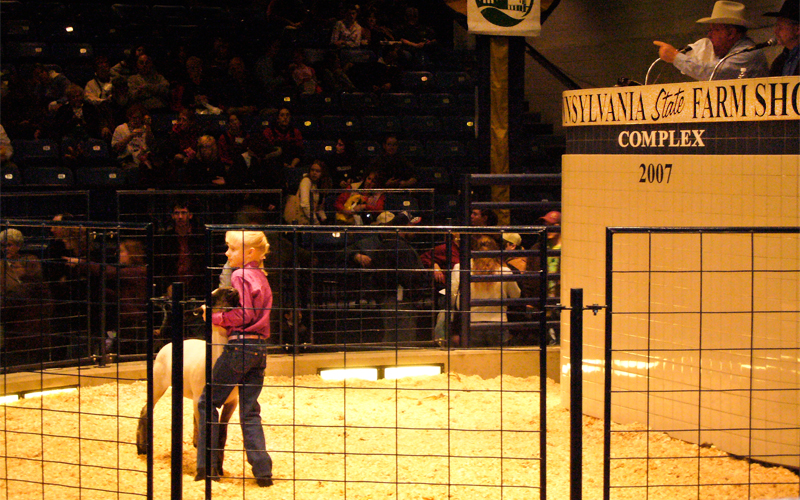
I know farmers in Brooklyn who raise bees on rooftops and kale in former junkyards. I’ve spoken at hippie organic-farming conferences in California at which I’ve met organic farmers, used to being considered outsiders, who are passionate about what they do. I’ve been in the homes of Mennonite farmers who speak Pennsylvania Dutch into their cellphones but drive a horse and buggy. I’ve been called a farmer (even though I’m not). Yet, nothing quite fascinates me as much as the Pennsylvania Farm Show, which has nothing organic, hippie, or Brooklyn about it.
Despite the cold weather, on opening day, 11,244 cars parked and thousands of people gathered to celebrate agriculture with 6,000 animals and more than 10,000 exhibits. For city dwellers (and other suburban, non-agricultural communities), it can feel like an alternate universe: where kids learn to sew camo outfits and enter square dancing competitions wearing them. Where teenagers raise the sheep, shear the sheep, make and dye the yarn, knit the sweaters, and then wear them with pride (and the end goal is probably not to sell them on Etsy). These are kids who raise rabbits for hopping contests and then win rabbit meat sticks as the prize.
A glimpse into this world reveals what many of us may assume to be a microcosm of rural self-sufficiency, charming pastimes (butter sculpture!), and a different breed of achievements (the Draft Horse Hall of Fame!). Scenes from the Farm Show may not translate to what we generally see in the modern media universe, on “foodie” cooking shows, or through the retailers selling artisanal cheeses. But many of the folks at the Pa. Farm Show identify as farmers, and they are part of the hugely vital group in America responsible for producing a majority of our food.
With one look at the square dancing “competition” (everyone is a winner!), where people of all ages, genders, races, sizes, and personalities (even men on tractors!) join the fun, you are reminded of the amazingly diverse spectrum of good people in the world: people who love their families, people who are trying to grow and learn, and people who are good at what they do, or are trying to be good. And like all people, farmers, regardless of their background and agricultural practices, are trying to succeed and find happiness in this great world.
It reminds me of what I learned while writing Organic Manifesto: that the number one thing that convinced a chemical farmer to switch to organic was having a neighbor go organic and succeed at it. In other words, when we get to know each other—with open hearts and minds—we can learn from each other. People from Brooklyn can learn how to make pickles and BBQ from the people who invented them. And people from rural farming communities can learn how to groom their beards more stylishly (just kidding!) and perhaps gain some confidence to become more organic and aware of the health and environmental implications of how we grow our food.
The thing is, neither group is better or worse than the other. But if neither group gets to know the other, the separate universes will continue to be a divide that prevents change, learning, and growth—for everyone! Just like a good organic farm, diversity is not only healthy, but it’s required. And diversity comes in all shapes and sizes—and color is just one type. So American farmers—in Pennsylvania, in Brooklyn, in California and everywhere else—it’s time to get to know one another! It’s time to learn from each other and have some fun square dancing (or dancing with the squares, as they call it in Pa.). It’s time to break down the walls that divide us and plant the seeds of a better, healthier, and more fun future.
I have a dream. I have a dream that one day the urban farmers and the hippie farmers will enter their fruits, vegetables, honey, and, yes, nuts into their state’s farm show competitions. I have a dream that every farm show (and state fair) will be organic. I have a dream that traditional farmers will retain their wonderful self-reliance and down-to-earth quirkiness—and that it will be OK for the urbanites and hippies to be different and still be respectful of the roots of our traditions. And I think this is already happening! The backyard farmers, the next generation, and all the hobbyists in between are emulating the practices and styles embodied by the great American heritage in farming.
There’s no need to make this transformation a conflict of cultures, when it’s really about safe and healthy food for everyone—no matter your location, your religion, your intellectual proclivities, or your taste in farm show fashions. We all desire to be authentic about who we really are, and to discover who we are, whether we’ve enjoyed the comfort of traditions or reinvented ourselves for modern times.
And if all food is organic, everyone gets a blue ribbon because we’ll all be (healthier) winners.




No comments yet.